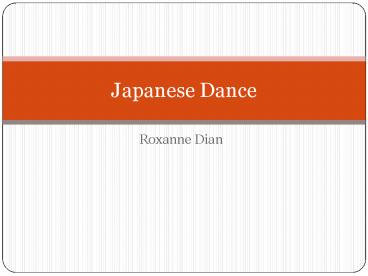Roxanne Dian - PowerPoint PPT Presentation
1 / 34
Title:
Roxanne Dian
Description:
Japanese Dance Roxanne Dian Bon ... Gigaku Bugaku There are two types of dances (and dancers) in Bugaku: left dances, from India, China, and Central Asia; and right ... – PowerPoint PPT presentation
Number of Views:113
Avg rating:3.0/5.0
Title: Roxanne Dian
1
Japanese Dance
- Roxanne Dian
2
Types of Dance and Theatre
- Early Dance
- Noh
- Kyogen
- Bunraku
- Kabuki
- Modern
3
Early Dance
- Kagura
- Gigaku
- Bugaku
- Dengaku
- Sarugaku
4
Kagura
- The Sun Goddess Amaterasu hid in a cave to
escape her storm god brothers behavior. The
goddess Uzume danced, and the laughter of the
other gods lured Amaterasu out of her cave. This
is the earliest mention of dance in Japanese
literature. The Kagura dances are said to be
directly descended from the dance performed by
Uzume. Because of this, it has strong religious
affiliations and is usually performed by
priestesses attached to a Shinto shrine.
5
Kagura
6
Gigaku
- Gigaku was brought over by a Korean dancer
around the 7th century. It began as simple dances
performed in front of Indian Buddha images. The
dance as it existed in Japan used large masks
that covered the entire head, and was accompanied
by a three-piece orchestra. While it is no longer
performed, it has had some influence on Noh
performance.
7
Gigaku
8
Bugaku
- There are two types of dances (and dancers) in
Bugaku left dances, from India, China, and
Central Asia and right dances, from Korea and
Manchuria. Left dancers, dressed in red, would
enter the stage from the left, and right dancers,
in green, would enter from the right. The themes
in Bugaku can be very abstract, and without
narrative quality. Dancers wear a mask or show no
facial expression.
9
Bugaku
10
Dengaku
- Dengaku grew out of traditional harvest dances.
It later acquired some narrative features and
became a fashionable pastime for the nobility.
11
Dengaku
12
Sarugaku
- Sarugaku began as court entertainment. It is
typically a comedic theatre act, often with lewd
themes.
13
Sarugaku
14
Noh
15
Noh
- Noh is performed on a specially-designed stage,
which changes very little from theatre to
theatre. The performers usually wear masks, and
move slowly, and with great control. It is
performed solely by men.
16
Noh
17
Noh
- Legend says that Noh was given to humanity by
the gods, sent down through a sacred pine tree in
Nara. Originally, the nearby villagers would all
dance, with any one of them acting as an
interpreter for the god. Eventually, they chose
one man as being an especially skilled
interpreter.
18
Noh
19
Noh
- Noh has existed for a long time. However, its
current form was largely developed by Kanami
Kiyotsugu and his son Zeami Motokiyo in the 14th
century.
20
Kyogen
- Kyogen is a short comical performance added into
a Noh performance to serve as comic relief. It
usually features no more than three actors. It
grew out of Sarugaku performances. They are
sometimes adapted into Kabuki performances.
21
Kyogen
22
Bunraku
- Bunraku is the puppet theatre of Japan. The
puppets are about a third of the size of a
full-grown adult. They can take as many as three
people to operate them. The plays performed in
Bunraku are similar to those performed in other
types of Japanese theatre, although they are
known for being especially violent.
23
Bunraku
24
Kabuki
- Kabuki began as a form of street dance, its
creation credited to a woman named Okuni near
Kyoto around the turn of the 17th century.
Originally, many of the performers were women
however, rowdy admirers causing problems led to
the government declaring that only men could
perform Kabuki.
25
(No Transcript)
26
Kabuki
- Performers use symbolic makeup and elaborate
costumes to portray characters. Stylized
movements and frozen poses are also a part of the
standard repertoire. Popular subjects are samurai
and courtesans, and love-suicides are common in
the plots of Kabuki plays.
27
Kabuki
28
Modern Dance
- Butoh is a Japanese form of modern dance that
began in 1959. Its original values included
exposing unpleasant social truths, although that
purpose has relaxed somewhat.
29
Bon Odori
- Obon is a traditional festival held each year
throughout Japan. Its purpose is to interact with
and show appreciation for the dead. It is always
in summer, although different communities hold it
on different dates. Traditionally, people go back
to their family homes and care for the graves of
deceased relatives as part of the holiday.
30
Bon Odori
31
Bon Odori
- The festival part of the holiday involves a
traditional dance called Bon Odori. Anyone can
participate. People dance, usually in a circle or
inward spiral (though occasionally through town
in a line) on a multi-tiered stage called a
yagura. The music typically uses drums, vocals,
and clapping.
32
Bon Odori
33
Bon Odori
- The story goes that Mokuren, a disciple of
Buddha, saw that his mother was suffering in the
afterlife because food kept turning to fire as it
reached her mouth. He asked the Buddha what he
could do to help her. The Buddha told him to make
offerings of food to the local monks. When he did
this and saw that he had saved his mother,
Mokuren danced for joy. That is where Obon and
Bon Odori come from.
34
Bon Odori































